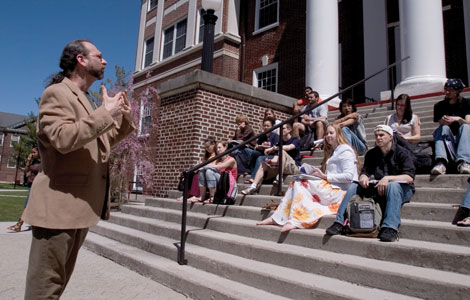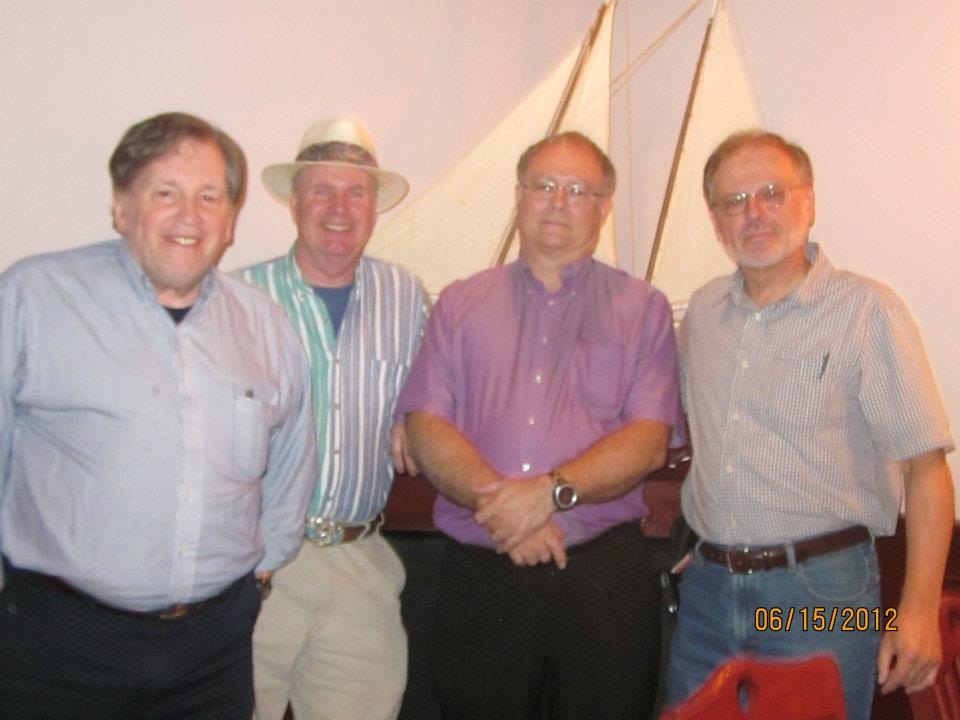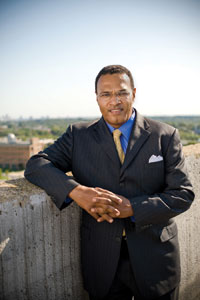Proposition: The natural sciences will forever be at odds with the humanities and social sciences. Steven Gimbel ’90, philosophy and physics, argues in the negative. As chair of the philosophy department at Gettysburg College and the author of works such as Einstein’s Jewish Science: Physics at the Intersection of Politics and Religion, Gimbel has made his career finding useful and provocative intersections between the sciences and the humanities and social sciences.
* * * * *
There are days in college that leave an indelible trace on your mind. I will never forget sitting in professor (and now professor emeritus of physics) Robert L. Rasera’s solid state physics class about two weeks from the end of the semester, when Jon Lau ’90, physics (who busted every curve), asked for clarification about the topic being discussed.
I recall that Rasera paused, and then said three little words: “We don’t know.” Not “I don’t know,” but “We don’t know.” And as he sketched out competing views, everything changed for me.
As a double major in physics and philosophy, I was used to discussing disagreements between philosophers – that’s just what philosophers do. But science had always been beautifully clean. Every problem had an elegant solution. All equations had seamless derivations. Problems were solved exactly.
That moment in Rasera’s class showed me that science was also a process involving people arguing with each other. It was the real physics, the messy physics, the human physics. I had found the philosophy in the science – and I have stayed there ever since.
As a philosopher of science, students often tell me: “This philosophy stuff is interesting, but I believe in science.” Their mistaken view is something one could easily infer from the way we do things. We create departments of physics, chemistry, and biology, and then locate them in buildings away from history, sociology, and political science. Much of what we do at universities can entrench the idea that these divisions are absolute. Natural sciences go in one box, pack the humanities in a different one, and leave the arts and social sciences to their own.
But it just isn’t so. There’s no competition here, and no need to choose sides. Indeed, these seemingly disparate disciplines are complementary, working together to create multifaceted minds that appreciate the full breadth of the world and derive insight and wisdom from it.
Sociologists like Robert K. Merton, historians like I.B. Cohen, and philosophers like Thomas Kuhn looked at scientific communities and the reasoning of individual scientists in order to embed discoveries in historical and cultural contexts. If we want to understand not only how the science works, but where it came from and why it appeared when it did, then we need to blend our disciplines across borders.
This is what I do in my latest book Einstein’s Jewish Science. The title comes from a phrase used by the Nazis to denigrate the theory of relativity. Like so much that came from Hitler and his minions, we now dismiss it as absurd propaganda. But look closely at the history of our sciences, and you’ll realize how inextricably intertwined they are with the politics, ideas, and religious beliefs of their day.
But interdisciplinarity isn’t merely a retrospective exercise. It is essential to developing the minds of scientists who will move us forward. During the last week of my first semester of quantum mechanics at UMBC, I remember professor of physics Ivan Kramer discussing the interpretation of the equations we had been studying. The theory itself, Kramer argued, was “a bunch of squiggles.” But then he asked what those squiggles meant.
Again, I found philosophy in my physics class. Because looking for meaning, after all, is what a philosopher does. Some of the squiggles represented mass or length – things that can be measured. Others were mathematical symbols, like an equal sign, that form the grammar of mathematical language. And there were more squiggles standing for potential field values, curvature tensors, and other weird things that we can’t see. If the theory is true, how do we make sense of these? What does the theory mean? What does the universe really look like if this theory describes how it works? The equation doesn’t answer these questions. Philosophy does.
This meditation leads us to two important elements of interdisciplinarity. First, what theory tells us about the world may compel us to completely change how we understand ourselves and our universe. Moving from a geocentric to a heliocentric view of the solar system did not change an inconsequential technical parameter. The earth was removed from the center of Creation. There were other planets just like ours, and other suns just like ours. This required a full reworking of our relation to the universe.
Scientific advancement and new technologies lead to yet another place where the sciences and humanities collide and collaborate. New discoveries force increasingly complex ethical issues onto the cultural stage. Technology gives us new tools and science gives us the know-how to use them in unforeseen ways. But the questions of meaning are urgent: Should we use them in those ways, or indeed at all?
Again, consider Einstein, who saw the horrors of the two world wars in which science and technology helped create mass death. Knowing that the great German physicist Werner Heisenberg had been enlisted by the Nazis to create an atomic weapon, Einstein and fellow physicist Leo Szillard wrote to warn President Franklin Delano Roosevelt. That letter helped create the Manhattan Project, which also led to the nuclear arsenals that shaped the Cold War and now stoke our greatest fears concerning terrorist organizations. Einstein later said: “I could burn my fingers that I wrote that letter.” Science yields knowledge, but that knowledge also forces weighty and complex moral decisions upon us.
We are faced with new and daunting ethical challenges each day because of the progress of science and the technology derived from it. That will not – and should not – change. But it does require us to shed the old way of thinking of knowledge in boxes. We must cross boundaries, weaving together the natural sciences, the social sciences and the humanities. This is what education for a new age needs. It is what I received – and what students still receive – at UMBC.
Tags: Fall 2012




